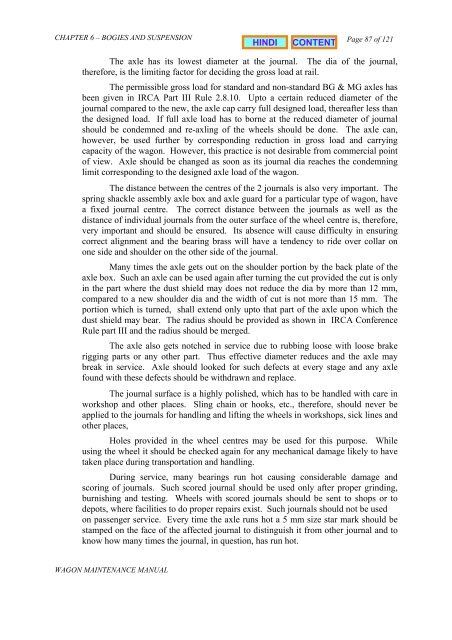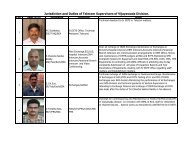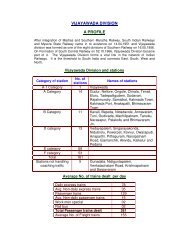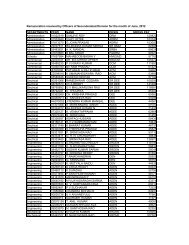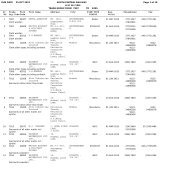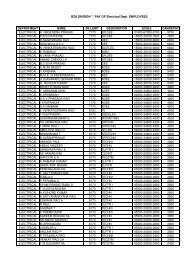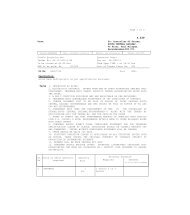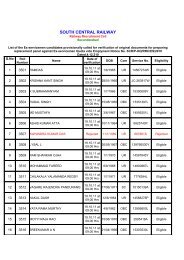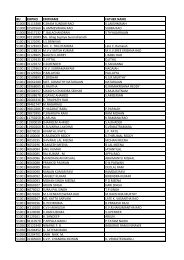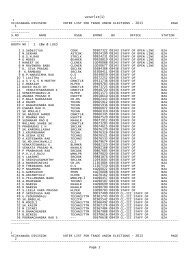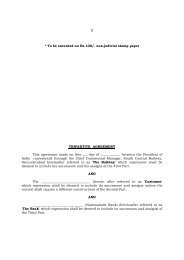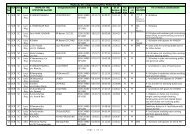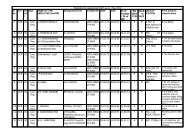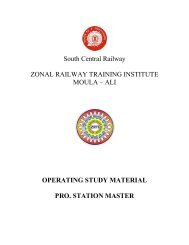BOGIES AND SUSPENSION - South Central Railway
BOGIES AND SUSPENSION - South Central Railway
BOGIES AND SUSPENSION - South Central Railway
Create successful ePaper yourself
Turn your PDF publications into a flip-book with our unique Google optimized e-Paper software.
CHAPTER 6 – <strong>BOGIES</strong> <strong>AND</strong> <strong>SUSPENSION</strong><br />
WAGON MAINTENANCE MANUAL<br />
Page 87 of 121<br />
The axle has its lowest diameter at the journal. The dia of the journal,<br />
therefore, is the limiting factor for deciding the gross load at rail.<br />
The permissible gross load for standard and non-standard BG & MG axles has<br />
been given in IRCA Part III Rule 2.8.10. Upto a certain reduced diameter of the<br />
journal compared to the new, the axle cap carry full designed load, thereafter less than<br />
the designed load. If full axle load has to borne at the reduced diameter of journal<br />
should be condemned and re-axling of the wheels should be done. The axle can,<br />
however, be used further by corresponding reduction in gross load and carrying<br />
capacity of the wagon. However, this practice is not desirable from commercial point<br />
of view. Axle should be changed as soon as its journal dia reaches the condemning<br />
limit corresponding to the designed axle load of the wagon.<br />
The distance between the centres of the 2 journals is also very important. The<br />
spring shackle assembly axle box and axle guard for a particular type of wagon, have<br />
a fixed journal centre. The correct distance between the journals as well as the<br />
distance of individual journals from the outer surface of the wheel centre is, therefore,<br />
very important and should be ensured. Its absence will cause difficulty in ensuring<br />
correct alignment and the bearing brass will have a tendency to ride over collar on<br />
one side and shoulder on the other side of the journal.<br />
Many times the axle gets out on the shoulder portion by the back plate of the<br />
axle box. Such an axle can be used again after turning the cut provided the cut is only<br />
in the part where the dust shield may does not reduce the dia by more than 12 mm,<br />
compared to a new shoulder dia and the width of cut is not more than 15 mm. The<br />
portion which is turned, shall extend only upto that part of the axle upon which the<br />
dust shield may bear. The radius should be provided as shown in IRCA Conference<br />
Rule part III and the radius should be merged.<br />
The axle also gets notched in service due to rubbing loose with loose brake<br />
rigging parts or any other part. Thus effective diameter reduces and the axle may<br />
break in service. Axle should looked for such defects at every stage and any axle<br />
found with these defects should be withdrawn and replace.<br />
The journal surface is a highly polished, which has to be handled with care in<br />
workshop and other places. Sling chain or hooks, etc., therefore, should never be<br />
applied to the journals for handling and lifting the wheels in workshops, sick lines and<br />
other places,<br />
Holes provided in the wheel centres may be used for this purpose. While<br />
using the wheel it should be checked again for any mechanical damage likely to have<br />
taken place during transportation and handling.<br />
During service, many bearings run hot causing considerable damage and<br />
scoring of journals. Such scored journal should be used only after proper grinding,<br />
burnishing and testing. Wheels with scored journals should be sent to shops or to<br />
depots, where facilities to do proper repairs exist. Such journals should not be used<br />
on passenger service. Every time the axle runs hot a 5 mm size star mark should be<br />
stamped on the face of the affected journal to distinguish it from other journal and to<br />
know how many times the journal, in question, has run hot.


